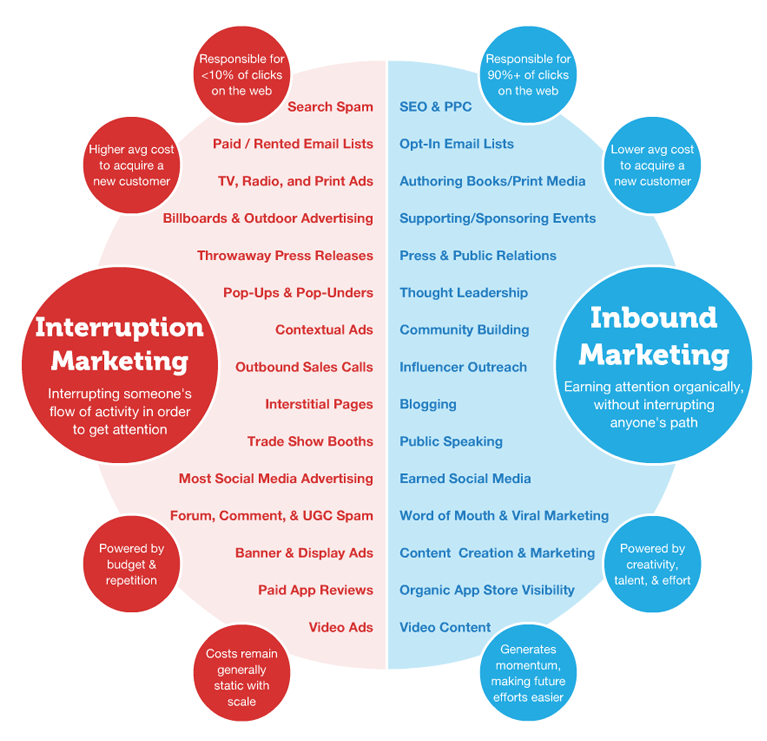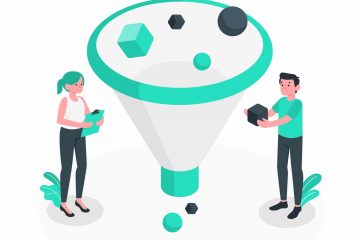What is Outbound Sales? Guide for B2B Businesses
In B2B, all sales strategies can be divided primarily into two categories: inbound and outbound. Roughly speaking, in inbound, the lead comes to you. In outbound, you go to the lead.

Source: Moz
Inbound Sales
In inbound sales, a potential customer comes to you and shows interest. These leads are often generated from inbound channels like advertising, SEO, etc. So, leads search for something, and then they find your product and visit your website to learn more information and check your product out.
Some examples of inbound marketing include:
- Advertising (mainly PPC)
- Content marketing
- Search Engine Marketing
- Social Media Marketing
There are pros and cons of an inbound strategy. Let’s look at them.
Pros:
- Good for long-term gains
- High ROI on organic strategy (long-term)
- Fast results on Advertising
- Increases brand awareness
- Good for developing relationships
- Generates leads with intent
Cons:
- The cost can be on the higher side initially.
- Asymmetrical results (Cannot be predicted)
- Strong competition can be faced.
- Achieving results can take time.
- An established sales and marketing framework is often required.
Outbound Sales
Outbound sales typically involve ‘reaching out’ to people who may or may not know your company already. Instead of creating paths for leads to reach you, you will instead find out prospects and contact them.
Some examples of outbound marketing include:
- Cold calling
- Cold email campaigns
- Door to door sales
- Social selling
As with inbound sales, outbound sales also has its pros and cons, some of which are listed below:
Pros:
- Can yield great results if done well
- Targets potential customers outside of your database
- Results can be achieved quickly
- Can often be achieved with limited marketing infrastructure in place
- Let’s you reach leads you otherwise couldn’t because of competition
Cons:
- Outbound leads are less likely to buy as they aren’t actively looking for a product or service that you offer.
- Harder to scale without sales infrastructure
- Harder to comply with international data regulations like GDPR
- Unpopular among some prospects. Many prospects dislike cold calls and emails.
- Poorer tracking and control compared to inbound sales.
- Poor results are more likely if not done properly. Strategy can be hard to crack!
- Risk of getting blocked by Email service providers (like Gmail).
Which strategy should you use?
It is the burning question for a lot of people and there is no single answer that fits all scenarios. If your product benefits from a sales-centric approach, outbound can be more beneficial.
On the other hand, if you are trying to create a presence in the market and build a significant digital footprint (like Hubspot, for example), inbound is what will bring you long-term results.
In many cases, it is best to use a combination of both for maximum results. The two will often go hand in hand with each other. If you are a small or medium-sized business with a limited budget, outbound can help you reach leads you would otherwise be unable to reach.
You can also use Account-based Marketing (ABM).
Account-based marketing is one of the most commonly used outbound strategies for B2B. In account-based marketing, companies create a set of target accounts. Marketing focuses on warming up these target accounts. It’s different than targeted marketing. You are not focusing on a defined market segment; you are focusing on real target accounts. So overall, you show up to those target accounts using a mix of inbound and outbound strategies. Marketing is more aligned with sales because they are working on generating revenue working with the sales department. Most ad platforms such as LinkedIn and Facebook support account-based targeting on their networks.
Yes, you read that. While ABM is fundamentally an outbound strategy, you can mix inbound with ABM. Website personalization or retargeting within your website are strategies that tools like Salespanel help you with on AMB strategy. Since this works on every kind of visitor regardless of whether one is identified or not, you get a competitive advantage by deploying your personalization on your 100% traffic rather than just focusing on inbound identified leads.
Is Outbound Marketing Suitable For B2B?
B2B is where outbound marketing gains an advantage. Businesses like to be sold to, and as a result, prospects are likely to be less hostile than any B2C scenario.
Businesses are always trying to remain competitive. They are always on the lookout for anything that might help to reduce costs, make them more efficient, and sell more. This means that if you do approach them with something that makes their business run more smoothly and more profitably, there’s a good chance that you will get their attention. Indeed, around 83% of buyers say that they have met directly with salespeople after being initially contacted through a cold call.
As with any marketing campaign, however, it needs to be done right.
First of all, you need proper planning. Who are you going to market to, for example? To be effective, your B2B outbound sales team will need to be focusing on the businesses that are most likely to need what you have. There’s no point in trying to sell safety clothing to retail shops because they are just not going to need them.
Also, make sure the team is well prepared and armed with a sales pitch if needed. There will be objections along the way, so a sales team needs to know how to overcome objections if they are to close the deal.
Something else you should definitely not overlook is the tools needed to do the job. There is a wide range available, and they make use of modern technology to help you get the best possible results. Not just for reaching out to prospects but for gathering prospect information and tracking leads.
Best Tools for Outbound Sales (Divided By Category)
Cold Calling Tools
Cold calling is perhaps one of the crudest marketing tools; some might even consider it archaic. It is still commonly used, however, and for a straightforward reason: It’s effective. Indeed, companies that still use cold calling see on average 42% more growth than those that don’t.
One of the essential tools for cold calling is a VoIP system, or similar. This allows you to make calls over the internet rather than using a standard telephone line which would cost you a lot of money.
In addition to cost-saving calling systems, you will also need platforms that help you manage your operations and keep everything organized.
One of the best-known cold calling tools is RingCentral, built specifically with outbound sales calls in mind. It offers powerful tools such as the ability to create different scripts that can then be used with the appropriate leads. Other powerful features allow you to manage your database effectively for easier use. Sophisticated reporting features are also available that help to monitor the effectiveness of your campaign and your individual sales reps.
Other well-known systems include:
- Aircall
- Outreach
- Toky
- VanillaSoft
- Myphoner
- PhoneBurner
- VICIdial
- Bitrix24
- CallPro CRM
It is a good idea to shop around first to find the solution that best suits your needs.
Email Marketing Tools
Another prevalent method of outbound sales is email marketing. Costs of email marketing are typically low, which means companies using it can see excellent ROI on their campaigns. Studies have shown that email marketing is 40% more effective at winning new customers than Twitter and Facebook combined.
Sending out a lot of emails can be a very time-consuming business, but there are some very powerful tools that can help you automate. One of the best known is Mailshake, which allows you to send automated cold emails directly from Gmail.
Most outbound email marketers also prefer to use personalization and use tools that offer better personalization features. Personalization helps emails stand out from generic emails and makes the recipient feel valued.
Other cold emailing tools include:
- Woodpecker
- Klenty
- Lemlist
- Mixmax
- Yesware
- Reply.io
When trying out these tools, keep an eye on nuanced features that are otherwise not noticeable but can be something you really need. For example, on Mailshake, you can upload new prospect lists on the same campaign (e.g., uploading new prospects every day or every week) and see stats for each list. This is something we found that is NOT available on Woodpecker. Small things can end up being deal-breakers.
Another example of innovation in this space is a feature called ‘Lemwarm’ offered by Lemlist. It helps you to warm up a brand new email address for cold emailing. This feature sends emails to other users of Lemlist by randomly generating some unique content. The user account, on the other side automatically replies using some algorithmic approach. It results in automated email exchanges, and it warms up the email account.
Lead Generation Tools
Ask 100 marketers what their most valuable marketing resource is, and the top answer is likely to be their database of leads. For outbound, you need leads. And, for leads, you need lead generation tools.
You can source leads that match your customer profile from several places. The most popular platform to get leads from is LinkedIn. LinkedIn is a B2B social interaction platform where many B2B businesses and their employees have a presence. You can use Sales Navigator to sort leads based on several lead and company data attributes and even engage with leads directly on the platform itself.
We would also like to pitch Salespanel for lead generation. Remember when we mentioned ABM on inbound leads? That’s where Salespanel comes in. It identifies accounts who visit your website even if they have never signed up. This basically means you get free leads for outbound from your existing traffic. You can also personalize your website and present tailored content to these accounts.
Other popular platforms include
- RocketReach
- BuiltWith
- Datanyze
- Growbots
With the incredible impact that a good database can have on your company’s fortunes, investing in lead generation software could turn out to be one of the best decisions you make.
Tracking and Analytical Tools
One thing that helps to make online marketing so effective is the analytical feedback you can get from your campaigns when they are up and running. For example, you can get powerful information such as who is clicking on ads and who is clicking through to what pages on your website.
Remember when we mentioned outbound analytics are harder? Salespanel helps you here again. Attach a tracking code to your outbound emails and Salespanel will capture leads and track their activities just like it does for inbound leads. Salespanel integrates with the most commonly used emailing tools.
Split Testing Tools
No matter how well designed your campaign is going, there are always improvements that can be made, especially considering how needs change over time. In some cases, even ‘simple’ changes like altering the text slightly, or even changing the color of a button, can make a big difference.
A/B testing tools make it easier for you to test different configurations of outbound emails and other digital marketing materials to determine which ones work best. Once you have found which works best, you can keep the new configuration to reap the rewards. You don’t stop there, either. With your new ‘best’ configuration, you then start testing more configurations to find an even better set-up.
This is very powerful because it helps you to make improvements to the performance campaign continually. It can also be very effective at helping you to keep ahead of market changes as they happen.
There are two steps on A/B testing on outbound. A/B testing your emails and A/B testing lead interactions once they are on your website. For emails, your cold emailing tool will already have A/B testing options. Tools like Close, Klenty, and Woodpecker have them.
On your website, VWO and Optimizely can be used to A/B test landing pages and marketing copies.
Conclusion
While outbound marketing is a grey spot for B2C as most consumers hate being sold to, it shines for B2B as businesses actively look for new solutions. It doesn’t cost them much to spend 2 minutes to read your pitch if it meant they could do their job better. Outbound is a great way to reach highly targeted prospects and turn them into customers.
Sell more, understand your customers’ journey for free!
Sales and Marketing teams spend millions of dollars to bring visitors to your website. But do you track your customer’s journey? Do you know who buys and why?
Around 8% of your website traffic will sign up on your lead forms. What happens to the other 92% of your traffic? Can you identify your visiting accounts? Can you engage and retarget your qualified visitors even if they are not identified?


